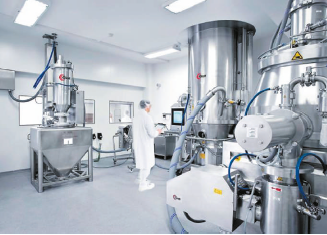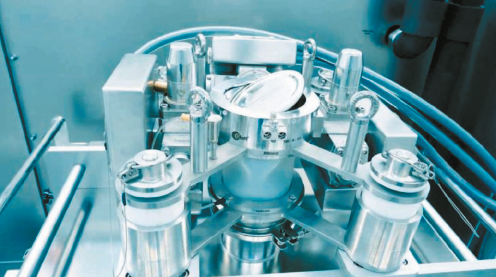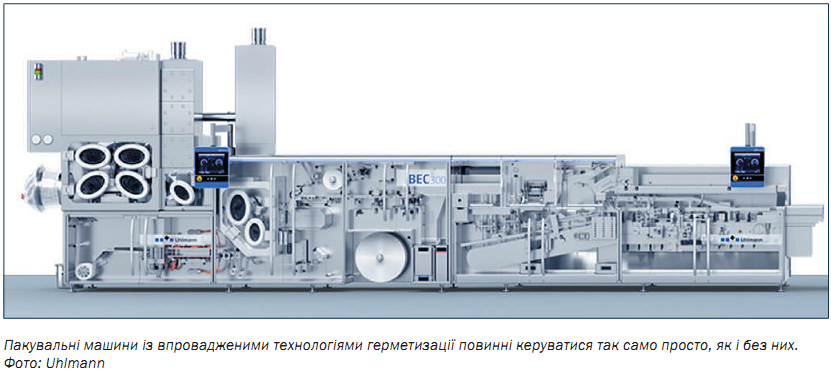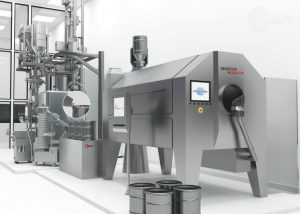The demand for economical containment solutions for the processing and packaging of pharmaceuticals is rising: On the one hand, this is because the proportion of highly potent active ingredients is steadily increasing – over 50% of all new active ingredients have an OEL of less than ten micrograms per cubic meter. On the other hand, this is because the active ingredients are increasingly sensitive to environmental influences such as moisture, heat or UV radiation. There is also a trend towards smaller batches, which manufacturers are countering by using flexible multi-product lines. However, this increases the risk of cross-contamination after batch changes, which is why it is better to clean the equipment and machines automatically if possible.
Christian Link, Director Application Engineering Packaging Systems at the packaging machine manufacturer Uhlmann, sees this trend clearly: "Twenty years ago, pharmaceutical manufacturers mainly worked with monolines, where only one active ingredient was packaged on the machine. Today, customers want to pack all kinds of things on one packaging line. And this cocktail will be a real challenge for all regulators in the future." That is why Link is confident when it comes to blister machines: "Containment is a good option because the alternative would be much more costly for operators."
 Without containment, production up to the packaging line would have to be set up in a clean room, for example, and the machines would need to be operated by personnel in protective suits. This involves ongoing costs for the people and materials entering and exiting, as well as for putting protective suits on and taking them off. In addition, this approach can result in tablet dust contaminating the machine and the surrounding area during production, necessitating costly cleaning cycles. "This, as well as operator qualifications, would take significantly longer than production using technical containment," Link said. In addition, the risk of cross-contamination increases significantly during "open" production in a clean room. Furthermore, there are high costs for setting up clean rooms: for example, for airlocks and building services. This is followed by high operating costs when taking into account energy costs, cleaning costs and times as well as clothing changes. "Taken as a whole, containment on the machine is the clear winner here," Link said.
Without containment, production up to the packaging line would have to be set up in a clean room, for example, and the machines would need to be operated by personnel in protective suits. This involves ongoing costs for the people and materials entering and exiting, as well as for putting protective suits on and taking them off. In addition, this approach can result in tablet dust contaminating the machine and the surrounding area during production, necessitating costly cleaning cycles. "This, as well as operator qualifications, would take significantly longer than production using technical containment," Link said. In addition, the risk of cross-contamination increases significantly during "open" production in a clean room. Furthermore, there are high costs for setting up clean rooms: for example, for airlocks and building services. This is followed by high operating costs when taking into account energy costs, cleaning costs and times as well as clothing changes. "Taken as a whole, containment on the machine is the clear winner here," Link said.
This is another reason why technical approaches such as the construction of containment within machines are becoming increasingly important. In this process, closed containers with solids are transported to the machine – for example, to a fluidized bed apparatus, a tablet press, or a blister packaging machine – and opened under containment conditions. Containment is then maintained until the tablets are completely sealed in the blister. The operating personnel can work without special protective suits. In the event of product and format changes, the containment lines are cleaned using a defined or qualified process and in comparison are quickly available again.

Considering containment in projects right from the start
From the point of view of the packaging machine manufacturer, it is important and preferable for containment to be considered in pharmaceutical industry projects from the beginning. The earlier that experts from the process equipment supplier are involved in the design of a new production plant, the better the interfaces between machines can be coordinated both mechanically and mechatronically.
The packaging machine manufacturer shares this view with process machine supplier Glatt: Both companies are part of Excellence United, an association of process equipment suppliers along the pharmaceutical value chain, which extends from active ingredient production to packaging. Michael Maintok, Business Development Manager Key Technologies at Glatt, has been observing the developments for years and sees a clear direction: "Containment is a trend because, on the one hand, more and more highly effective products are being processed, and on the other hand, regulatory requirements are becoming increasingly stringent." Maintok is convinced: "Highly active, pure active ingredients have to be handled in a closed environment – this can’t be done outside an isolator." From the point of view of the containment expert, this is also about protecting plant personnel. However, the risk of cross-contamination of the active ingredients also has to be eliminated. And this – according to Christian Link and Michael Maintok – can be managed much better in the defined, enclosed space of a machine than in an open clean room area.
The containment experts at Excellence United, which also includes packaging machine supplier Harro Höfliger and tablet press manufacturer Fette, recommend that their customers actively discuss containment with suppliers at an early stage of the project. This allows individualized concepts to be developed that take into account both the need for minimizing risk with regard to product and personnel as well as limiting the expense of the containment solution to the bare minimum. This is because although containment systems are expensive to purchase, they show their advantages during operation.
The experts take a self-critical view that what was technically possible in the early days of containment technology was in part the benchmark and drove up costs. Containment solutions are still considered expensive. However, the situation has changed with growing experience on the part of providers and operators: When it comes to the scope of a containment solution, the maxim today is "as little as possible, as much as necessary." An aspiration that, first and foremost, requires an intensive exchange between the project partners.
Considering not only the operating staff, but also the technicians
Operators and technology suppliers are also increasingly focusing on possible failure scenarios when designing containment systems. This makes it much easier to limit the effects of accidents in closed machines than in complete clean rooms. The members of Excellence United can draw on their own measurements and experience from joint projects. Thus, according to Michael Maintok, it is not only the production area that has to be considered – the containment concept also plays an important role in the technical areas and components "Technicians who change filters, for example, have to be protected by the containment just like regular production workers." Process machinery supplier Glatt keeps these aspects in mind when designing its fluidized bed equipment, granulators and machine interfaces. And for Uhlmann as well, packaging machines with containment should be as easy to operate as machines without it. "With intelligent designs, we lay the groundwork in the early stages of a project. The earlier we talk to the customer about the operator/machine interface and understand how the customer wants to use the machine, the better we can design it," says Christian Link.
A fact that, in the experience of the containment experts, also applies to the interfaces between machines and in the project: "We can also draw on the experiences that we've had as a group in the past," says Link. "From spray dryer to packaging, all Excellence United companies are involved, and in the end the customer has a production chain that is the right fit and that meets all regulatory requirements. There is no gap between machines in our joint projects." The association's member companies can also draw on a growing treasure trove of data and measured values: This allows members to exchange information on exposure measurements and practical experience and contribute this expertise to new projects. "Unlike us, our customers don't do this every day. We, on the other hand, transfer the knowledge we gain from one project to another, thereby creating real added value," Michael Maintok and Christian Link explain.
Glatt Ingenieurtechnik GmbH
Nordstr. 12, 99427 Weimar, Germany
Phone: +49 (0) 3643 / 47-0
Fax: -1231


